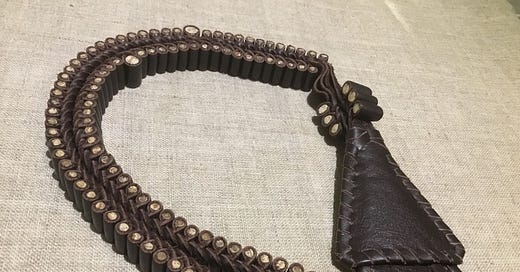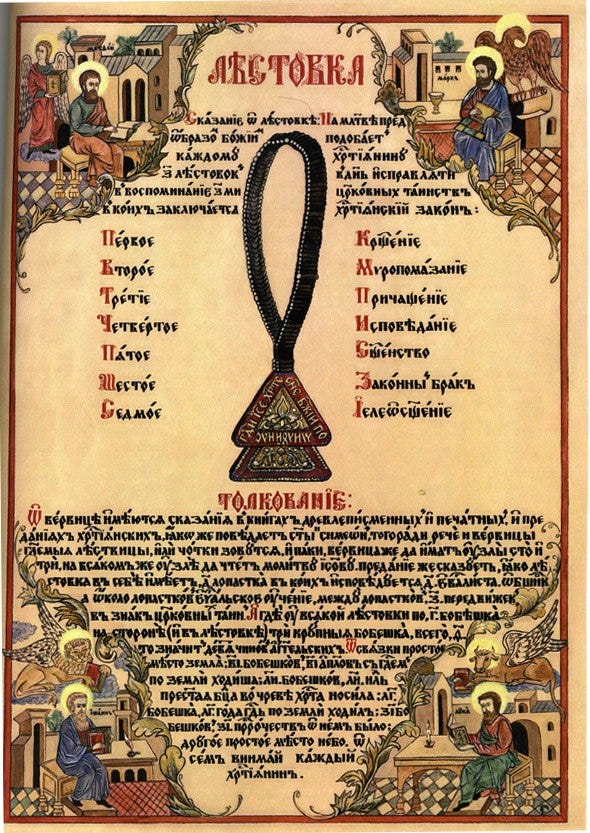Here is another “basic” article, about the prayer rope of Old Believers. It is a stated requirement that the faithful have their lestovka with them in the temple, using it for silent prayer if it happens to be that they cannot understand what is being sung or read, or if they become distracted. This highlights an important point, that the faithful have an obligation to be praying with the service, ideally the prayers being chanted or sung, but if this is not possible, then with the Jesus Prayer, using their “ladder”. To stand idly is not permitted, for the temple is for communal prayer.
These ladders are constantly utilized for counting “Lord have mercies”, and without the aid of your ladder, you will find yourself in the position of speaking a prayer while your mind is wholly focused on keeping a count, which is no prayer at all.
New ladders are also presented to newlyweds at their wedding.
One point not made by the article is that it is possible to see ladders with a Cross, almost exclusively among New Believers (I have never seen an Old Believer use one). This should be avoided because the use of the ladder involves prostrations, which would allow the Cross to touch the ground, and this is strictly forbidden.
Another point is that the prayers (and prostrations) said for the three “large steps” (“Remember me…”) are not universally observed, some claiming that this is a newer practice and that the large steps are to be skipped when utilizing the ladder for a prayer rule, meaning their purpose was strictly for counting or for symbolic separation of the steps.
Lestovka – is a diminutive from the Old Russian word lestvitsa, meaning ladder. This device is used for counting prayers and is a mandatory accessory for both laypeople and clergy, visibly expressing the hidden, continuous prayerful communion of a person with God. Generally, a lestovka symbolizes the moral ascent of the petitioner on the path to salvation.
Each element of it is symbolic, significant, and filled with spiritual content. In the 4th century, St. Basil the Great introduced the first prayer rope, or more precisely a vervitsa – a small rope loop with one hundred and three knots (for the number of knots see Nomocanon at the Great Euchologion, p.30) in the monasteries he founded for the proper counting of prayers. By the seventeenth century, the vervitsa was adorned, enriched, and transformed into the lestovka, the direct description of which we now turn to.
The lestovka consists of a closed loop made up of intertwined “steps”, with its start and end fixed between two pairs of triangles, called lapostki. The closed circle is a sign of ceaseless prayer and eternity. The triangular shape of the lapostki is established in honor of the Holy Trinity – the indivisible and co-equal confession of the three Divine Persons of one God: Father, Son, and Holy Spirit. The name lapostok comes from the word lopat (blade). In the "Dictionary of Russian Folk Dialects" we find one meaning: Lopat – a decoration on icons of wedge-shaped patches of material, bordered with ribbon. In the book "The Doctrine of the Worship of Christ's Church (Old Believer)" (published in 1913 by the Moscow Old Believer Institute at the P.P. Ryabushinsky printing house), on page 9 we read:
The two lapostki ending the ladder symbolize the two tablets of God's covenant (received by Prophet Moses), which in the New Testament are disclosed in the four Gospels (four sides of the two lapostki, sewn pairwise). Often, the evangelists (or their names) are depicted on the lapostki, whose gospel should guide Christians in prayer and in life."
The trim around the lapostki signifies the Gospel teaching. Inside, between the upper lapostki, seven small patches (movable pieces) are sewn, which are typically not visible from the outside. They symbolize the sacraments of the holy Church: 1) Baptism; 2) Chrismation; 3) Holy Orders; 4) Eucharist (Communion); 5) Confession (Repentance); 6) Matrimony; 7) Unction.
The established number of steps for the lestovka is one hundred and three, i.e., 100 small and 3 large (excluding six special steps at the top of the lapostki). Like any ladder, this prayer ladder has a beginning: a free space without steps, called "earth," followed by the first twelve small steps, in honor of Christ's twelve apostles. Then, after the first large step, thirty-eight small steps in honor of the thirty-eight weeks and two days that the Most Holy Mother of God carried the Infant Christ. After the second large step, symbolizing halfway of the journey, follow thirty-three small steps, in honor of the thirty-three years of the earthly life of the Lord Jesus Christ. After the third large step, another seventeen small steps signify the number of Old Testament prophecies about the Savior. Next is a simple space, called "heaven." Separately, at the upper edge of the lapostki on both sides, there are three large steps, which together with the other three large ones located in the circle of the lestovka, make up the number nine. They symbolize the nine orders of angels, having three classes (according to John of Damascus), by their level of service and closeness to God: the highest (thrones, cherubim, seraphim), middle (dominions, powers, authorities), and lowest (principals, archangels, and angels) (see Dionysius the Areopagite "On the Celestial Hierarchy").
The design of the lestovka meets the practical needs of worship services (for instance, during the 40, 30, 50, or 12-fold recitation of the "Lord, have mercy" prayer), and it is also used for personal prayer rules at home, which are individually assigned by a spiritual father based on personal characteristics. The lestovka also assists illiterate Christians who pray at home not from a book, but with their lestovka, as well as for people who are hard of hearing or have poor vision, and, while attending church services, silently recite the Jesus Prayer using a lestovka, without bows, to remain in prayerful communion with other Christians.
Each lestovka should be prayed in the following manner for all cases of cell (home) prayer: The first and last three steps (from the top edge of the lapostki), with the prayer: "Alleluia, Alleluia, glory to Thee, O God," with earthly bows. Small steps with the Jesus Prayer (“Lord Jesus Christ, Son of God, have mercy on me, a sinner”), with earthly or belt bows. At the first large step (after the 12) is said the the prayer: "Remember me, Lord, when Thou comest into Thy kingdom"; with an earthly bow (prostration). The second large step – with the prayer: "Remember me, Master, when Thou comest into Thy kingdom"; and an earthly bow. The third large step – with the prayer: "Remember me, Holy One, when Thou comest into Thy kingdom"; and an earthly bow.
At the end of the lestovka: "Lord, have mercy (thrice). Glory to the Father, and to the Son, and to the Holy Spirit, now and ever and unto ages of ages, amen." Then we begin the next one. Depending on the assigned rule, or by personal desire, prayers are also offered to the Holy Trinity, the Honorable Cross, the Mother of God, the Guardian Angel, and the saints, with the corresponding refrains.
Prayers using the lestovka can replace the daily cycle of church services, the reading of the Psalter, and preparation for confession and communion (for more details, see the "Prayer Book" of modern publication). We provide here the simplest rule with bows, applied as needed, for church services from the "Prayer Book" (pp. 43,44). For Vespers: one hundred bows. For Compline: fifty bows. For Nefimon, which is Great Compline (in Great Lent): three hundred bows. For Midnight Office: one hundred bows. For Matins: two hundred bows. For the First Hour: fifty bows. For the Hours: two hundred bows.
All these are belt bows.
However, in Great Lent, seventeen earthly bows are prescribed for each lestovka: "More honorable than the cherubim..." and the prayer of St. Ephrem the Syrian with prostrations.
During prayer, the lestovka is traditionally held in the left hand, with fingers positioned practically the same as when making the sign of the cross. In this position, it is convenient to count the number of prayers recited with the thumb.
The primary prayer on the chotki is the Jesus Prayer: "Lord, Jesus Christ, Son of God, have mercy on me, a sinner." This prayer, symbolically represented as a scroll, is contained in each step (it is actually written on a paper and wrapped around every individual wooden dowel). Like a staff, this prayer crushes demons, burns sinful thoughts, and step by step, gradually leads the soul to moral perfection.
Together with the prayer, we make the sign of the cross, "crucifying" ourselves to Christ. In the book "Eldership", in the eleventh word, we read: "Placing our hand on the head, we say: Lord. With this word, we proclaim the eternal and unoriginate birth of the Son of God, from the Father without Mother before all ages. And then we move the hand from high to low, i.e., from the head to the belly or navel, saying: Jesus Christ. This denotes the descent of the Son of God from the heavenly spheres, from the unoriginate depths of the Father's glory to the earth, and into the immaculate womb of His Mother, the Virgin Mary, His seedless conception and incarnation. And again from below, i.e., from the navel, we raise the hand to the right shoulder or side, saying: Son of God. This again represents the glorious ascension of the Son from earth to heaven and His sitting at the right hand of the Father[…]. And from there again we carry the hand crosswise to the left shoulder, saying thus: Have mercy on me, a sinner, or have mercy on us. Herein we ask the Lord to free us from the present standing and from the torment of sinners" (see "Rules of Pious Behavior in the House of God", p.97).
The lestovka is an essential accessory for an Orthodox Christian. According to the teaching of the Holy Church, we need to perform prayers in the church, at home, and on the road, so the lestovka is an indispensable accessory for an Orthodox Christian, and the prayer through it is a spiritual sword feared by demons, by which evil thoughts are destroyed. Any good thing brings benefit when used for its intended purpose; for instance, a weapon is deadly to the enemy when it is in the hands of a warrior – in our case, a warrior of Christ.
In the church, Orthodox Christians must stand with a lestovka, made, if possible, from leather, beads, or other materials. The manufacture and artistic decoration of lestovka, especially recently, has become quite varied; one could say it has been and remains one of the traditional crafts of Orthodox Old Believers, much like weaving a belt – a necessary item of clothing for an Old Believer.





St Elizabeth Convent ☦️🕯️📿 out of Minsk got four of these delivered to Central Oklahoma, Estados Unidos in twelve Days. CHRIST IS RISEN! 🌹🌬️✳️The Feast of MidPentecost, 2024. Grace and Peace to you. ⛲🔥🌐
This refers to a Slavonic edition, but the same information is printed in the Erie Old Orthodox Prayer Book, in English. It is in the appendix in the back of the book.